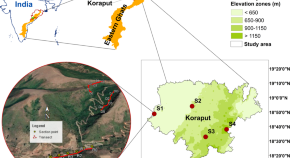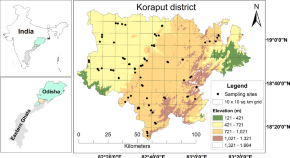Spatial and seasonal patterns of temperature lapse rate along elevation transects leading to treelines in different climate regimes of the Himalaya
Authors (first, second and last of 4)

Collection
The ongoing climate change is unequivocally anthropogenic and—together with other drivers like deforestation, land degradation, biological invasion, etc.—has resulted in species losses and shifts in landscape dynamics. The carbon cycle and the water cycle, arguably the two most important large-scale processes for life on Earth, depend on biodiversity at genetic, species, and ecosystem levels and can yield feedback to climate change. Geomatics and data analytics have revolutionized our understanding of the impacts of climate change and ecosystem responses. The effects of climate change are particularly felt in fragile ecosystems like the Himalayas, which harbor rich biodiversity and support several dependent communities. Understanding the advances made in the interface of climate change with biodiversity and ecological sciences from a bioresources-rich country like India, would help building climate change-resilient ecosystems for realizing sustainable development goals such as United Nation Sustainable Development Goals 13: Climate Action and 15: Life on Land.
This special issue will include invited papers presented during the 3rd International Workshop on Biodiversity and Climate Change (BDCC-2023) organized by the Centre for Ocean, River, Atmosphere, and Land Sciences (CORAL) at Indian Institute of Technology Kharagpur (IITKgp) during February 16-19, 2023 in Kharagpur, India. The objectives are to understand feedback between biodiversity and climate change; to highlight the role of bioresource management and sustainable development; and to explore the recent advances in spatial biodiversity. The contributions will cover various themes such as biodiversity and land cover dynamics, Geomatics and data analytics, forest and agricultural bio-resources, and the Himalayan climate.
Keep up with the latest Biodiversity and Conservation content by signing up for Journal Alerts today!
With outstanding contributions to the fields of forest remote sensing, land and water resources management, and ecological climatology through theorizing, modeling and conducting innovative experiments and field-based measurements, Dr. Behera has developed innovative protocols and new methods for estimating a range of vegetation photosynthetic/structural variables including leaf area index, canopy height, aboveground biomass and productivity using a suite of satellite data products and modeling. He decoded the intrinsic relationships between land use and land cover change and hydrological processes using geospatial technologies.
Associate Professor at the Centre for Biodiversity and Taxonomy in the Department of Botany of the University of Kashmir, Dr. Khuroo's research specialization is in plant taxonomy, ecology and biodiversity. The current focal areas of his BIOTA (BIOdiversity & TAxonomy) Lab include floristics, invasive alien plants, alpine ecology, plant phenology and climate change in the Indian Himalaya. With two decades of experience, Dr. Khuroo published over 180 research papers and co-authored two Springer books. He is also Associate Editor for Biological Invasions (Springer) and Subject Editor for Check List (Pensoft).
Professor of Biodiversity and Conservation of Natural Resources, Central University of Odisha, Prof. Palita has published 50 research papers, several book chapters, a book, and has handled numerous research projects. His area of research includes studies primarily on faunal diversity, distribution, and ecology in forest, grassland, mountain, and aquatic ecosystems including mangroves. Prof. Palita’s research group works on faunal groups like bats, birds, butterflies, fishes and earthworms in the biodiversity-rich northeastern Ghats region of Odisha which is undergoing fast changes due to rapid industrialization and urbanization.
Professor of Ecology in the Department of Botany at North-Eastern Hill University, Shillong, India, Prof. Barik has published 160 research papers, 12 books and 40 technical and research reports. He explained the high species richness in subtropical forests on the basis of niche segregation and existence of distinct regeneration guilds during gap-phase regeneration. Prof. Barik quantified the hypervolume niche of several plant species and extensively used Ecological Niche Modeling (ENM) as a tool for new species discovery, corridor planning, and successful reintroduction of species.









